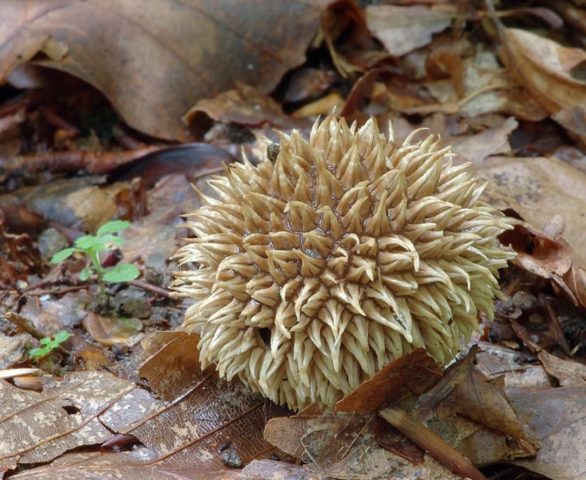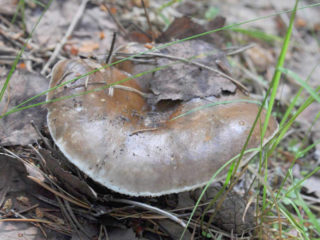Content
Puffball black-prickly, needle-shaped, spiky, hedgehog - these are the names of the same mushroom, which is a representative of the Champignon family. In appearance, it can be confused with a small furry hummock or a hedgehog. The official name is Lycoperdon echinatum.
What does a black-prickly raincoat look like?
It, like many of its relatives, has an inverted pear-shaped fruiting body, which tapers at the base and forms a kind of short stump. The surface of young specimens is light, but as they mature it becomes light brown.
The diameter of the upper part reaches 5 cm.It is completely covered with curved spikes-needles 5 mm long, which are arranged in rings. Initially, the growths are cream-colored, and then darken and turn brown. During the ripening period, the thorns fall off, exposing the surface and leaving a mesh pattern. In this case, a hole is formed in the upper part through which the fungus releases ripe spores.

The thorns of the black-prickly raincoat are arranged in rings, with the longest one in the center and short ones all around
The flesh is initially white, but when ripe it turns purple or brownish-purple.
At the base of the mushroom you can see a white mycelial strand, thanks to which it is firmly held on the soil surface.
The spores are spherical with characteristic spines on the surface. Their size is 4-6 microns. The spore powder is initially cream-colored and changes to purple-brown when ripe.
Where and how does it grow
This mushroom is classified as rare. The fruiting season begins in July and lasts until the end of October, subject to favorable conditions. Grows singly or in small groups. It is found in deciduous forests, as well as on heather heaths in mountainous areas.
Prefers calcareous soil. Distributed in Europe, Africa, Central and North America.
Is the mushroom edible or not?
The puffball is edible as long as its flesh is white. Therefore, it is recommended to collect only young mushrooms. In terms of nutritional value, it belongs to the fourth category.
It must be boiled or dried before use.The bramble-prickly raincoat does not tolerate transportation over long distances, so it should not be collected if you plan to take a long walk through the forest.
Doubles and their differences
In terms of external features and description, the black-prickly puffball is in many ways similar to its other relatives. Therefore, in order to identify doubles, you need to know their characteristic differences.
Similar lookalikes:
- The raincoat is ragged. The surface of the fruit body is covered with cotton-like white flakes. The main color is light cream or ocher. Considered edible. It grows in the southern regions, found in oak and hornbeam forests. The official name is Lycoperdon mammiforme.
The ragged puffball is considered one of the most beautiful representatives of the Champignon family.
- The raincoat is smelly. Common type. A distinctive feature is the dark color of the fruiting body with brown curved spines that form star-shaped clusters. Young specimens emit an unpleasant odor that resembles lamp gas. Considered inedible. The official name is Lycoperdon nigrescens.
The stinking puffball should not be eaten even at an early age when the flesh is white
Conclusion
The black-prickly puffball has an unusual appearance, making it difficult to confuse it with other relatives. But when in doubt, the flesh should be cracked. It should have a pleasant aroma and a dense white texture. When collecting, keep in mind that this species cannot be carried in a basket for a long time.










